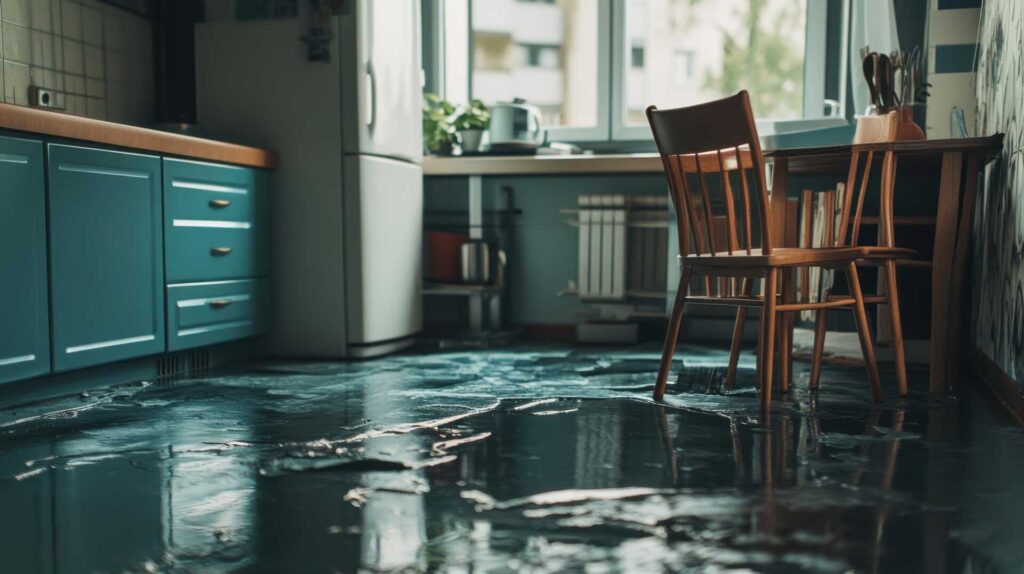
Contents
When faced with a flood, understanding effective floodwater restoration techniques becomes critical. From evaluating damage to employing advanced extraction methods, each step plays an important role in minimizing impacts. It’s important to take into account ongoing mold prevention and structural integrity restoration to ensure resilience. Let’s explore the best practices that can help you navigate this challenging process successfully.
Key Takeaways
- Conduct a thorough damage assessment and document findings with photographs for insurance claims and safety measures.
- Utilize high-powered pumps for fast water extraction and vacuum extraction for precision in smaller areas.
- Ensure effective drying through air circulation, dehumidifiers, and moisture monitoring to prevent mold growth.
- Implement mold prevention strategies by controlling humidity, inspecting for leaks, and disinfecting affected areas.
- Restore structural integrity by assessing damage, replacing compromised materials, and using moisture-resistant materials for long-term resilience.
Assessing the Damage and Safety Precautions
Before you begin any restoration efforts, it’s essential to assess the damage and take necessary safety precautions.
Start with a thorough damage evaluation of your property. Look for structural issues, mold, and electrical hazards. Document everything with photographs to support potential insurance claims.
Next, prioritize safety measures. Wear protective gear like gloves, boots, and masks to shield yourself from contaminants. Make certain the electricity is turned off before entering flooded areas to avoid shock. Use a flashlight to navigate, as seeing may be difficult in murky water.
If you encounter standing water, avoid it until it’s deemed safe. Be cautious of hidden dangers like sharp objects or unstable flooring.
Engaging with professionals for a detailed assessment can also provide peace of mind. Taking these steps safeguards your health and sets the foundation for effective restoration, allowing you to reclaim your space with confidence.
Effective Water Extraction Methods
Once you’ve assessed the damage, it’s vital to implement effective water extraction methods to minimize further loss. Using high powered pumps is important, as they can quickly remove large volumes of water, considerably reducing the risk of mold and structural damage. Vacuum extraction is another effective technique, ideal for smaller areas where precision is needed.
Here’s a quick comparison of these methods:
| Method | Pros | Cons |
|---|---|---|
| High Powered Pumps | Fast extraction, handles large areas | Can be expensive |
| Vacuum Extraction | Precise, ideal for confined spaces | Slower, may require multiple passes |
| Combination Approach | Maximizes efficiency | Requires more equipment |
Drying and Dehumidification Techniques
As you move forward with the restoration process, drying and dehumidification techniques play an important role in preventing mold growth and further damage.
First, ensure effective air circulation by using fans and opening windows. This helps disperse moisture-laden air, accelerating the drying process. Combine this with dehumidifiers to extract excess humidity from the environment, which is vital in maintaining ideal moisture levels.
Next, implement moisture monitoring to track the progress of your drying efforts. Use moisture meters to check various surfaces, confirming they reach safe levels before proceeding.
Pay special attention to hidden areas like walls and underfloor spaces, as they can retain moisture and compromise your restoration. By actively managing air circulation and monitoring moisture, you’ll create a healthier environment and protect your property from long-term effects.
These steps will foster a sense of security as you restore your space to its former condition.
Mold Prevention and Remediation Strategies
To effectively prevent mold growth during the restoration process, it’s essential to maintain low humidity levels and secure thorough cleaning of affected surfaces. You should implement mold identification techniques to detect early signs of mold, allowing for swift remediation.
Here’s a quick reference table to guide your prevention methods:
| Mold Prevention Method | Description |
|---|---|
| Control Humidity | Use dehumidifiers to keep humidity below 60% |
| Regular Inspections | Check for leaks and water damage regularly |
| Clean & Disinfect | Use appropriate cleaners on affected areas |
| Ventilation | Secure proper airflow in damp areas |
| Address Condensation | Insulate cold surfaces to prevent moisture |
Restoring Structural Integrity and Finishing Touches
While restoring structural integrity after a flood, it’s essential to assess the extent of damage to ensure effective repairs.
Begin by evaluating the foundation, walls, and beams for signs of weakness or rot. Use moisture meters to detect hidden water pockets, as they can compromise stability.
Once you identify damaged areas, prioritize structural repairs and replace compromised materials with high-quality alternatives to ensure long-lasting support.
After addressing the structural integrity, shift your focus to the finishing touches. This might include repainting, installing new flooring, or adding trim.
Choose moisture-resistant materials to prevent future issues and enhance aesthetics. Remember, these finishing touches aren’t just cosmetic; they contribute to the overall resilience of your home.
Finally, ensure proper ventilation to help maintain a dry environment, reinforcing the structural integrity you’ve worked hard to restore.
You’re not just rebuilding; you’re creating a safe, welcoming space for yourself and your loved ones.
Wrap-Up
In the delicate dance of floodwater restoration, you’re not just mopping up; you’re nurturing your space back to life. By carefully evaluating the damage, swiftly extracting water, and ensuring every corner dries thoroughly, you’re laying a foundation for resilience. With effective mold prevention tactics and restoring structural integrity, you create a sanctuary that stands strong against future storms. Embrace these techniques, and you’ll transform a challenging setback into a renewed, vibrant environment.
Recent Posts
Top 3 Flood Restoration Techniques You Need
When dealing with flood damage, you need to focus on three critical restoration techniques. First,
Top Techniques for Flood Water Damage Restoration
When dealing with flood water damage, you need a systematic approach to restore your property
